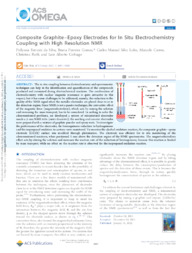Composite graphite epoxy electrodes for in situ electrochemistry coupling with high resolution NMR.
Composite graphite epoxy electrodes for in situ electrochemistry coupling with high resolution NMR.
Autoria: SILVA, P. F. da; GOMES, B. F.; LOBO, C. M. S.; CARMO, M.; ROTH, C.; COLNAGO, L. A.
Resumo: The in situ coupling between electrochemistry and spectrometric techniques can help in the identification and quantification of the compounds produced and consumed during electrochemical reactions. The combination of electrochemistry with nuclear magnetic resonance is quite attractive in this respect, but it has some challenges to be addressed, namely, the reduction in the quality of the NMR signal when the metallic electrodes are placed close to or in the detection region. Since NMR is not a passive technique, the convective effect of the magnetic force (magnetoelectrolysis), which acts by mixing the solution and increasing the mass transport, has to be considered. In seeking to solve the aforementioned problems, we developed a system of miniaturized electrodes inside a 5 mm NMR tube (outer diameter); the working and counter electrodes were prepared with a mixture of graphite powder and epoxy resin. To investigate the performance of the electrodes, the benzoquinone reduction to hydroquinone and the isopropanol oxidation to acetone were monitored. To monitor the alcohol oxidation reaction, the composite graphite?epoxy electrode (CGEE) surface was modified through platinization. The electrode was efficient for in situ monitoring of the aforementioned reactions, when positioned 1 mm above the detection region of the NMR spectrometer. The magnetoelectrolysis effect acts by stirring the solution and increases the reaction rate of the reduction of benzoquinone, because this reaction is limited by mass transport, while no effect on the reaction rate is observed for the isopropanol oxidation reaction.
Ano de publicação: 2022
Tipo de publicação: Artigo de periódico
Unidade: Embrapa Instrumentação
Palavras-chave: Electrochemical reactions, Magnetoelectrolysis, Nuclear magnetic resonance
Observações
1 - Por padrão são exibidas publicações dos últimos 20 anos. Para encontrar publicações mais antigas, configure o filtro ano de publicação, colocando o ano a partir do qual você deseja encontrar publicações. O filtro está na coluna da esquerda na busca acima.
2 - Para ler algumas publicações da Embrapa (apenas as que estão em formato ePub), é necessário ter, no celular ou computador, um desses softwares gratuitos. Sistemas Android: Google Play Livros; IOS: iBooks; Windows e Linux: software Calibre.
Acesse outras publicações
Acesse a Base de Dados da Pesquisa Agropecuária (BDPA) para consultar o acervo completo das bibliotecas da Embrapa.

